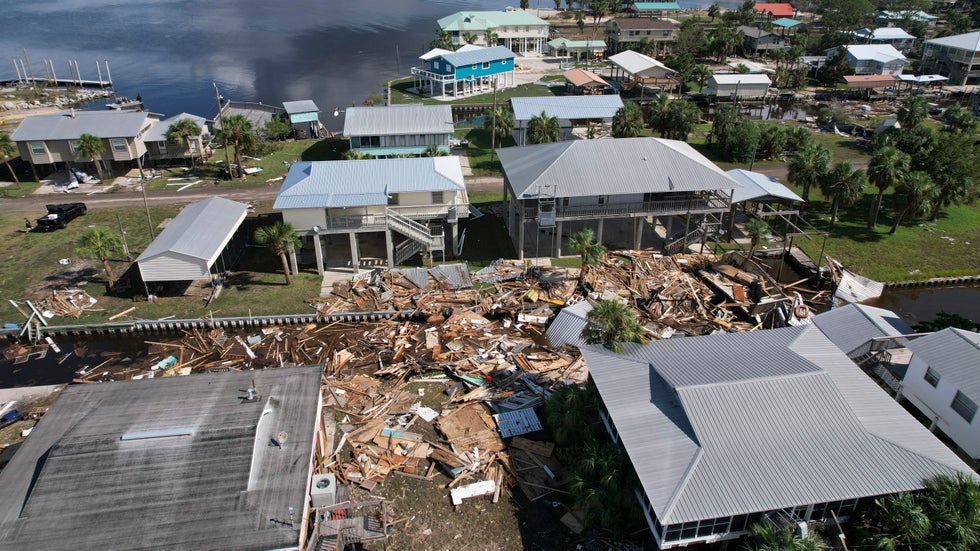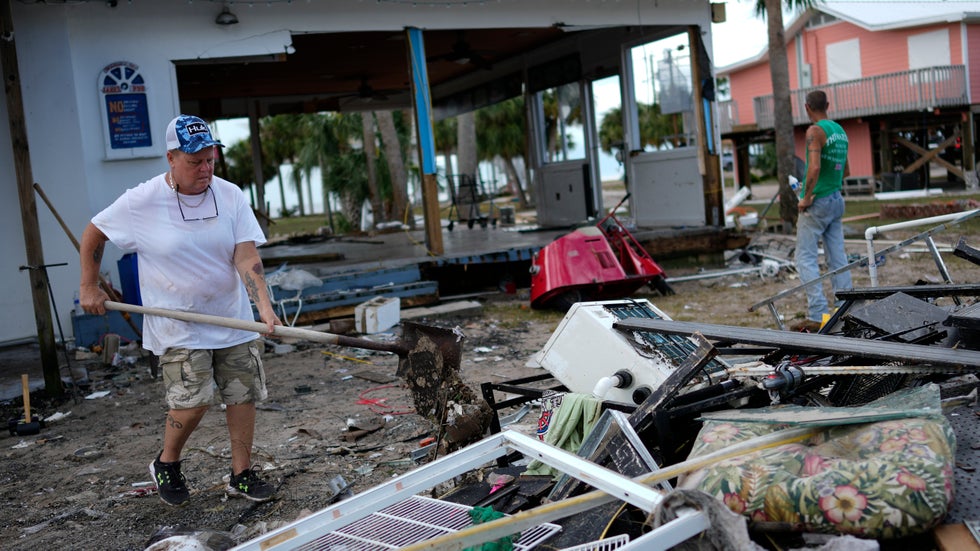Jan Wesner Childs
Hurricane after hurricane, there's always one thing that stands out in communities wrecked by storm surge.
Homes built on concrete slabs are washed away, while those built on stilts often survive unscathed.
The images beg the question: Why aren't all coastal homes elevated?
The answer is a complicated one.
"Why you see one construction type in one area versus another is the confluence of a lot of different things largely having to do with history and with regulation," Jesse Keenan, a Tulane University expert in real estate and climate, told weather.com.
(MORE: Aerial Photos Show What Idalia Left Behind)
The history part relates to different building materials, methods and design styles that evolve over time. The regulation side involves a myriad of rules and complexities that range from the federal government down to local planning boards.
 In this photo taken with a drone, debris from homes swept off their lots litters a canal amid homes on stilts which survived, in Horseshoe Beach, Fla., Thursday, Aug. 31, 2023, one day after the passage of Hurricane Idalia.
In this photo taken with a drone, debris from homes swept off their lots litters a canal amid homes on stilts which survived, in Horseshoe Beach, Fla., Thursday, Aug. 31, 2023, one day after the passage of Hurricane Idalia.Who Decides If A Home Should Be Built Elevated Or Not?
How high a home needs to be off the ground in coastal areas is guided by base flood elevation, a metric used by the Federal Emergency Management Agency to measure and map flood risk.
But experts have been warning for years that FEMA's flood risk maps are outdated and don't account for rising sea levels and other impacts of climate change.
A 2020 analysis by the nonprofit First Street Foundation discovered nearly 6 million homes that should have been identified as at-risk by FEMA but were not.
(MORE: 7 Things Florida Newcomers Should Know About Hurricane Season)
Besides outdated maps, surveys and other information used to calculate a home's elevation are also not always accurate.
"A lot of people are in flood zones and they don't know it," Keenan said.
"The point here is that even if we have standards, a lot of times we're either not enforcing it or we're not meeting those standards because we don't have the data to know whether we're compliant or not," Keenan said.
What Is A Stilt House?
Stilts, more formally called pier foundations, are pilings that raise a building off the ground anywhere from a few feet to a couple of stories. In many cases, the lower level is open to allow sand and water to wash through. In others, it's enclosed with walls intended to give way to storm surge but leave the stilts standing.
"The lower level of these elevated homes are designed as breakaway, so that wave action essentially knocks the wall systems down," Todd Wolter, president of a company that's been building homes on Sanibel and Captiva islands in Southwest Florida for 37 years, told weather.com in an email.
"We saw these predominantly concrete structures, which are designed to 170 mph winds, perform reasonably well during a direct hit by Hurricane Ian.”

Not Everyone Can Afford A Home On Stilts
Elevated construction can add a considerable amount to the cost of home construction. And when it comes to rebuilding after a hurricane, a typical insurance policy isn't going to cover it.
Things get especially tricky, Keenan said, when FEMA's "51% rule" kicks in. That mandate requires that any damage beyond 50% of its value has to be brought up to all current codes if it's rebuilt.
(MORE: Sunny Day Flooding Keeps Getting Worse, According To New NOAA Report)
The rule is intended to help protect homes against future damage, but it also creates a financial burden in areas with older homes, like communities in Southwest Florida hit by Hurricane Ian last year. Keenan said it's one reason people end up selling their destroyed properties instead of rebuilding.
"And that's going to be part of a broader demographic shift, particularly for retirees and people on fixed incomes that simply won't be able to entertain recovery from these shocks, time and time again," Keenan said. "They simply won't be able to afford it."
There are nonprofit programs that can help with the cost, and more assistance may be on the horizon.
Climate Change Will Make Future Damage Worse
Global warming is driving rising sea levels that make storm surge and flooding worse. Scientists say climate change is also causing hurricanes to rapidly intensify more often and to carry more moisture.
All of that means there are several issues at play in building - or rebuilding - homes.
(MORE: Here's How A Warmer World Could Affect Hurricane Season)
"It's critically important to think about how we build. But it is many, many more times important and critical that people understand that the real question is where we build," Keenan said.
"Because you can build a perfectly resilient home that's got all the bells and whistles of design, engineering and technology, materials. But if you build it in a wrong location, those designs are quite limited and they're certainly not going to protect you from the inundation of sea level rise."
The Weather Company’s primary journalistic mission is to report on breaking weather news, the environment and the importance of science to our lives. This story does not necessarily represent the position of our parent company, IBM.
The Weather Company’s primary journalistic mission is to report on breaking weather news, the environment and the importance of science to our lives. This story does not necessarily represent the position of our parent company, IBM.

No comments:
Post a Comment